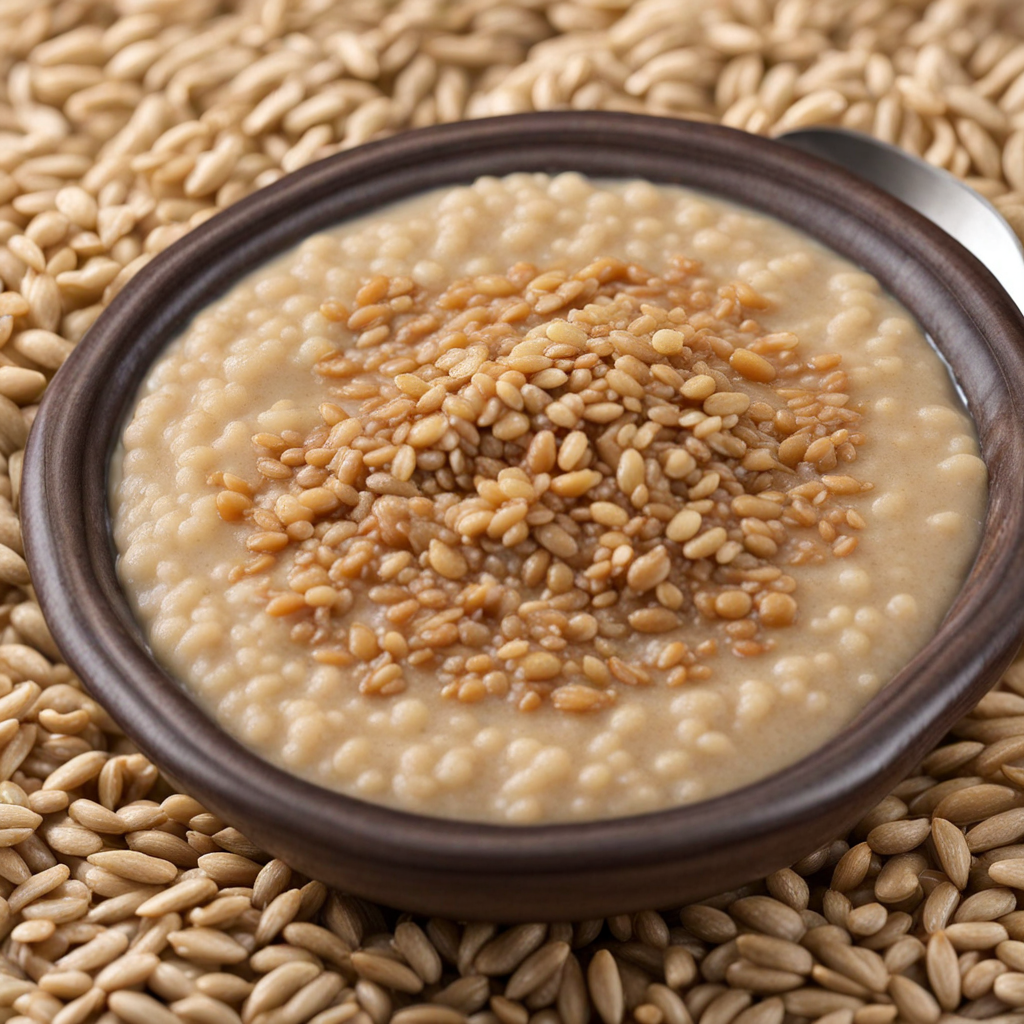Aseed
Aseed is a traditional Yemeni dish that offers a unique blend of flavors and textures, making it a true culinary gem. The dish is primarily made from a dough-like mixture of flour and water, which is cooked until it reaches a smooth, thick consistency. This base is often enhanced with spices like cumin and coriander, giving it an aromatic profile that is both earthy and comforting. Aseed is typically served on a large platter, where it forms a mound at the center, inviting diners to gather around and share in the experience of this communal dish. The true beauty of Aseed lies in its versatility, as it can be paired with a variety of accompaniments. Commonly, it is served with a rich sauce made from meat, chicken, or vegetables that have been simmered with a medley of spices, creating a hearty and satisfying meal. The sauce is poured generously over the Aseed, allowing the flavors to meld together beautifully. Diners often use their hands to scoop up the Aseed along with the sauce, making each bite a delightful combination of textures and tastes. In Yemen, Aseed is more than just food; it is a symbol of hospitality and community. It is often prepared for special occasions and gatherings, where families and friends come together to enjoy this delicious dish. The experience of sharing Aseed, with its warm and inviting flavors, fosters a sense of connection and celebration that is deeply rooted in Yemeni culture. For anyone looking to discover a new taste, Aseed promises to be an unforgettable journey into the heart of Yemen's culinary tradition.
How It Became This Dish
The History of 'عسيد' (Asid) from Yemen #### Origins ‘عسيد’ (Asid), a traditional dish from Yemen, is a staple that has not only nourished generations but also served as a symbol of cultural identity and resilience. The origins of Asid can be traced back to the ancient civilizations that flourished in the Arabian Peninsula. Yemen, with its rich history and diverse geography, provided the perfect backdrop for agriculture and culinary innovation. The primary ingredients of Asid—wheat flour, water, and sometimes barley—are reflective of the agricultural practices in the region. Wheat has been cultivated in Yemen for thousands of years, thanks to the fertile highlands and the ancient irrigation systems developed by the Sabaeans, a civilization known for its sophisticated agriculture. Barley, on the other hand, was one of the first domesticated grains and has been part of the human diet since prehistoric times, further linking Asid to Yemen's agricultural roots. #### Cultural Significance Asid is more than just food; it is a vessel of cultural expression. In Yemeni society, meals are often communal, and Asid plays a central role in gatherings, celebrations, and daily life. Typically, Asid is served as a main dish, accompanied by various stews or sauces, such as 'saltah'—a hearty meat and vegetable stew flavored with fenugreek and served piping hot. The act of eating Asid is communal; diners tear pieces from the large mound of the dish and dip them into the accompanying stews, fostering a sense of togetherness and shared experience. The preparation of Asid is also steeped in tradition. It is often made by mixing flour with water to form a dough, which is then kneaded and cooked until it reaches a soft, pliable consistency. The process may vary from family to family, with some preferring to use traditional clay pots for cooking, imparting a unique flavor to the dish. The making of Asid is often a family affair, with mothers teaching daughters the nuances of the recipe, ensuring the preservation of culinary heritage. Moreover, Asid holds a significant place in Yemeni culture during special occasions. For weddings, Eid celebrations, and other significant events, Asid is often prepared in large quantities to feed guests, showcasing hospitality and generosity. The dish symbolizes abundance and the importance of sharing food, reflecting the values inherent in Yemeni society. #### Development Over Time Asid has evolved over the centuries, adapting to the changes in Yemen's social, economic, and political landscapes. Historically, Yemen was a crossroads for trade, with merchants traveling through the region, bringing spices, grains, and cooking techniques from various cultures. As a result, the preparation of Asid has incorporated influences from neighboring regions, while still retaining its roots. During the Ottoman Empire's rule over Yemen from the 16th to the 19th centuries, culinary practices saw a blend of Ottoman influences, which introduced new spices and cooking methods. However, Asid remained a steadfast part of the Yemeni diet, revered for its simplicity and heartiness. It became a symbol of Yemeni identity, especially during times of hardship, such as famine or conflict, when it served as a reliable source of nourishment. In the 20th century, Yemen underwent significant political changes, particularly during the unification of North and South Yemen in 1990. The unification brought about a renewed interest in traditional Yemeni cuisine, including Asid, as a means to foster national identity. Culinary festivals began to emerge, celebrating the diverse food heritage of Yemen, and Asid was often featured prominently. #### Modern Interpretation In contemporary times, Asid has found its place in the global culinary scene, as the Yemeni diaspora has spread across the globe, bringing their culinary traditions with them. Yemeni restaurants in cities like London, New York, and Dubai have introduced Asid to a broader audience, often adapting traditional recipes to cater to local tastes without losing the essence of the dish. Social media has played a pivotal role in this culinary renaissance, allowing home cooks and chefs to share recipes and cooking techniques with a global audience. Platforms like Instagram and TikTok have become venues for showcasing traditional dishes like Asid, promoting cultural appreciation and inspiring a new generation to embrace their culinary heritage. Despite the challenges posed by globalization and the rapid changes in food culture, Asid remains a beloved dish in Yemen and among Yemenis abroad. It encapsulates the essence of Yemeni hospitality and the spirit of community, serving as a reminder of home for many who have emigrated. #### Conclusion In conclusion, Asid is much more than a simple dish; it is a testament to Yemen's rich history, cultural significance, and resilience through the ages. From its ancient agricultural roots to its modern interpretations, Asid embodies the heart of Yemeni culinary tradition. As the world continues to evolve, so too does Asid, adapting to new contexts while remaining a cherished part of Yemeni life. The communal nature of enjoying this dish not only nourishes the body but also strengthens the bonds of family and community, ensuring that the legacy of Asid will continue for future generations.
You may like
Discover local flavors from Yemen







